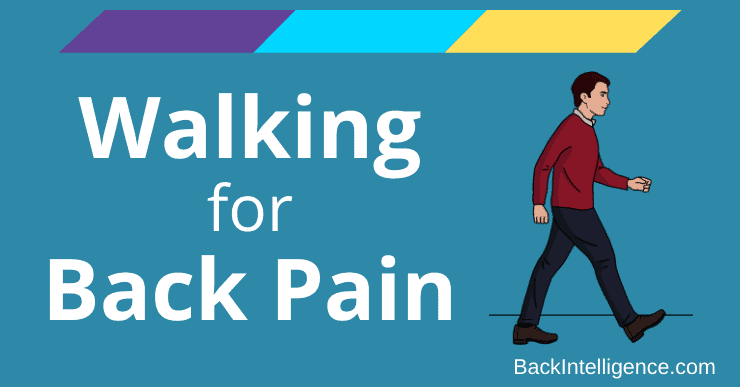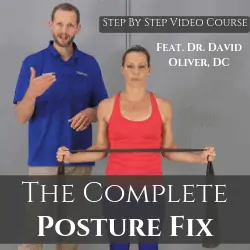
Often low back pain is caused by lifestyle choices like sitting too long, lack of consistent exercise, or bending and lifting improperly rather than any specific pathology.[1]
It is important to recognize that movement early in your recovery process will improve your pain, not make it worse.[1]
Exercise, mobility work, bracing, core strength have all shown to be effective at reducing Low Back Pain,[2] but what about walking?.
Incorporating walking into your daily routine is one way to increase physical activity and improve low back pain.[6]
What does the research say?
Walking has been shown to be just as effective as exercise at reducing Low back pain. In one study, researchers compared the effectiveness of walking with other forms of physical exercise. They found that low back pain, disability, and quality of life improved the same amount whether someone was walking or performing other forms of exercise. However, walking didn’t show to be superior to other physical modalities.[3]
In another study, walking proved to be effective at reducing chronic pain, as well as increasing muscle endurance (aka strength) in the low back.[2]
And this study found: “Low- to moderate-quality evidence suggests that walking intervention in patients with chronic LBP was as effective as other non-pharmacological interventions on pain and disability reduction in both short- and intermediate-term follow-ups.”[5]
This means that walking can be a great, inexpensive alternative to physical exercise when addressing low back pain.
Benefits of Walking:
- Increases muscle endurance[2]
- Decreases low back pain[3][4]
- Decreases stress
- Improves quality of life
- Less expensive alternative to physical therapy[3]
- Decreased risk of tissue damage or other injuries[11]
- Improves mood and work status[10]
- Decreases the need for pain medication
The question then becomes, how much walking is enough to improve your pain?
A study published in The Spine Journal in 2019 attempted to understand the relationship between weekly walking duration and low back pain in the Korean general population. Based on questionnaires, 482 participants over the age of 50 years old provided information about how much they walk and answered questions about their medical history including history of back pain. They were classified into two categories of walking: 30 minutes per day, and 1 hour per day. The results showed that the risk of low back pain decreased as the walking days and duration increased. Therefore, the results showed that walking 3 days a week for more than 30 minutes is significantly associated with a lower risk of LBP for those over 50 years old.[4]
What if you have to sit or stand for a long time at work?
Static positions like sitting or standing for a long time can aggravate low backs and lead to achiness and pain. One study showed that taking short, 5-minute walking breaks every 25 minutes decreased the percentage of people who developed low back pain.[7]
This suggests that inserting short walks throughout your day may provide essential movement that your back needs to prevent the onset of low back pain.
Contraindications for walking:[12]
- Anyone who is at an increased risk for arrhythmias, cardiovascular collapse, or respiratory distress with walking at a usual pace.
- Anyone who has had a myocardial infarction or unstable angina in the prior month should wait to begin a walking program on their own and consult a medical professional first.
- Make sure to stop walking and see a medical professional if you start experiencing excessive fatigue, chest pain that gets worse with increased effort, or any other symptom that does not subside at rest.
Walking Program:
- Start with two 10min walks each day.
- Work up to walking 20-30 min per day. Try to do it around the same time each day to begin building a habit.
- Once you can walk for more than 30 min at a time, add “long days” into your week. This means 2-3 days a week walk up to an hour then go lighter the following day. Your body needs longer periods of recovery as the duration and intensity of walking increases.
Below is a weekly schedule that you can work up to. You can add light 1-3 lb weights in your arms as you walk and increase your speed to progress your walking workouts.
Monday: 1-hour walk
Tuesday: 30 min walk plus stretches
Wednesdays: 1-hour walk
Thursday: 30 min walk plus stretches
Friday: 30 min walk plus stretches
Saturday: 1-2 hour walk (LONG DAY)
Sunday: Recovery light walking throughout the day
Shoe Tips:
- MAKE SURE YOU HAVE GOOD WALKING SHOES. TAKE CARE OF YOUR FEET!
- You should replace your shoes every 6-12 months and rotate among different pairs.
- By re-distributing your weight in different shoes, it can give some structures of your feet rest and strengthen others.
Walking Tips:
- Imagine a balloon attached to your head and pulling you straight up. You want to walk tall rather than sinking into your hips.
- Slightly lean forward from your hips and propel yourself forward with your buttocks.
- Brace your core as you walk (Contract your abs)
- Step onto a bent knee, not with a locked knee.
- Swing the opposite arm to the leg stepping forward.
- Walk at the pace that feels right for you (pain-free)
- Let your arms swing somewhat freely (with relaxed shoulders)
- Breathe normally as you walk.
In summary, walking can be a great way to prevent or improve low back pain. Try walking for short periods first, and then progress gradually.
If you are worried that your low back pain will not improve, talk to your physical therapist, chiropractor, or another licensed medical practitioner about how you can recover faster (Also check out our programs). If your low back pain becomes chronic you may benefit from exercises that are more intense than walking.
Your physical therapist can help develop an individualized exercise program that will improve your endurance and strength and decrease your pain. Low back pain is not to be feared! Walking is a great place to start.
The Complete Posture Fix (With Dr. Oliver)
Fix your fwd head and rounded shoulders posture, get out of pain and increase your mobility.
Learn More
Related:
5 takeaways from Economist on Chronic back pain
True Sciatica Versus Piriformis syndrome
How long does Sciatica last?
How to fix hyperlordosis
Sources:
[1] Delitto A, George SZ, Van Dillen L, et al. Low back pain. J Orthop Sports Phys Ther. 2012;42(4):A1-A57. doi:10.2519/jospt.2012.42.4.A1
[2] Suh, JM, Kim, Hayoung BS, Jung GP, Ko JY, Ryu JS. The effect of lumbar stabilization and walking exercises on chronic low back pain. Medicine. 2019;98(26): e16173. doi: 10.1097/MD.0000000000016173
[3] Vanti C, Andreatta S, Borghi S, Guccione AA, Pillastrini P, Bertozzi L. The effectiveness of walking versus exercise on pain and function in chronic low back pain: a systematic review and meta-analysis of randomized trials. Disabil Rehabil. 2019;41(6):622-632. doi:10.1080/09638288.2017.1410730
Dr. Courtney Livingston is a Doctor of Physical Therapy and certified Strength and Conditioning Specialist. She graduated from the MGH Institute of Health Professions and is currently working as an orthopedic physical therapist in the Dance Medicine Program at Spaulding Rehabilitation Hospital outside of Boston, Massachusetts. She treats all ages and backgrounds and particularly enjoys working with Salsa, Bachata and Ballroom dancers.


